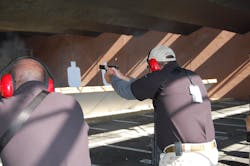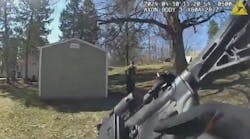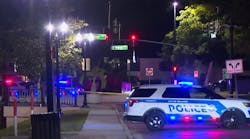Having been a firearms instructor for over 23 years, a law enforcement officer and an active LE shooter since 1982, I thought I’d distill some lessons. Many of these lessons are included in our new book Citizen's Guide to Armed Defense.
#1 If your agency only offers once a year visits to the range for qualification, then see to it that you engage in your own live-fire training. Supplement your live-fire with dry-fire on a regular basis. Better yet, invest in a S.I.R.T. (Shot Indicating Resetting Trigger) training pistol or a LaserLyte plastic training pistol with a LT-PRO red laser. Both of these training devices have decent sights and resetting triggers to allow you to safely practice your pistol skills in between visits to the range. I’ve been trying to use my SIRT pistol on days when I’m not working the range. I incorporate my pistol work with empty hand strikes and kicks on the heavy bag and calisthenics, using simulated cover positions of all heights.
Put simply, you gotta train on a regular basis!
#2 Arrive early with the gear you need to go to work. Get your gear together prior to heading to the range so you have all you need – pistol, spare mags, duty belt or holster, mag carrier, body armor, eye and ear pro, flashlight if needed, appropriate clothing and related needs – water, sunscreen, etc.
Agency personnel must qualify with the holster they carry on duty. Pet peeve of mine is D.B. personnel showing up with Sam Browne duty belts. The oft given excuse is, “Well I work a lot of off-duty jobs.” This comment is made from detectives who wear a holster and no spare magazines while working. Neither of these practices are acceptable. Pistols carried without spare ammo are temporary solutions and detectives need to practice and qualify with the holsters they carry. Here is a novel approach, take an old suit coat to the range so you can practice draws from concealment and the restrictive nature of a sport coat while shooting. When I worked plainclothes street narcs, I would practice and train with a shirt or jacket covering my holster. I wanted to recreate the actual conditions of a draw-stroke on the street as much as possible.
In terms of clothing, that includes attire suitable for the weather – hot/sunny, rainy, or cold/snowy. Being miserable for a day or half-day detracts from the training. I prefer officers wear tighter crew neck shirts. These prevent hot brass from the shooter next to you going down your shirt. This is uncomfortable with pistols but when 5.56 carbine brass if flying around, ejected at about 500 degrees, this poses safety issues and can burn skin. In that regard, always wear headgear that includes a ball cap when able. I’ve seen too many incidents where ejected brass fell behind safety glasses. In addition to injury, many shooters will turn away from the target line with pistol in hand!
#3 Have the right attitude. As an instructor, you can tell and appreciate, those officers who come to the range with a squared away attitude. Even if you’re not “a shooter” or “into guns” firearms training is serious business and proper focus and intent are vital. Get into it. As my buddy Chris Cerino from the Cerino Training Group is want to say, “It’s only a piece of paper, stuck to some cardboard, stapled to two pieces of wood.” In other words, to mentally prepare, think of that paper target as a real suspect trying to kill you. Get emotionally involved and focused.
Even with this many years on the J.O.B., I still pump myself up and focus when shooting a qual course or engaging in training. I don’t ever want my firearms training, my preparations for saving my life or another’s to become so blasé that I couldn’t care less. I’ve never bought into the excuse that individual morale based on agency actions impacts training for the fight. I think of this as an excuse by unmotivated folks. If you won’t train for yourself or your family, don’t blame the agency for your lack of intensity. It will not be them in that firefight, it will be you and your skills, attributes and abilities.
#4 Listen to the range instructors. I know many veteran officers, and some rookies, think they got this figured out but it is our (range instructor’s) business. We have your best interests at heart and want you to be properly prepared for the street. So, when we say something, it is rarely to hear ourselves speak (when you talk for a living sometimes you get tired of hearing your own voice…). Oftentimes officers will respond with, “I know.” Truth is, you don’t know. If you did know you would be doing it on your own. As a firearms instructor I’ve repeated this mantra numerous times, “If all you ever do, is what you’ve already done, all you’ll ever get, is what you already have. You will never improve.” Humble yourself to the training experience. Yes, there are burned out, unprofessional, unmotivated instructors but you can even learn from them (even if it’s how not to do something). The bulk of instructors are trying their best, listen and learn.
#5 Run the gun in practice or training as you would on the street. Do not engage in admin only activities if at all possible. These admin actions create training scars. For instance, when loading and making ready on the line, do so with the same skills that would use to reload on the street. Walking up to the line with a magazine already inserted into your holstered pistol, and then brining the pistol out to low-ready and racking the action before reholstering robs you of the chance to do one perfect reload repetition. I’ve actually seen shooters who practice this, reholster their pistol to reload while running simulated combat shooting events.
When loading or reloading – bring the gun into your “workspace” or “safety circle” and load from your magazine carriers. When unloading, draw to full presentation, then bring the pistol back to your workspace and remove the magazine as well as cycling the action several times. This give you realistic reps, not training scars.
#6 Strive for consistency. Learn the right grip, presentation from the holster and trigger press then repeat them to a point you are consistently performing the actions. Many struggling shooters never achieve any type of consistency. Each time they visit the range it is like the first time. You cannot get good at shooting until you can perform the fundamentals of marksmanship consistently without conscious thought. This level of mastery is easily accomplished with time and training.
Remember, the magic is in the trigger and sights. Just ran a retired LEO through a qual course yesterday. He shakes like a Pekinese passing a peach pit but he qualified with a perfect score because he smoothly fires and operates the pistol without disturbing the sights.
#7 Train for a career and a lifetime! These skills are not easily attained and cannot be maintained without due diligence! That means time and practice on a regular basis. As mentioned before, such practice need not be restricted to live fire. Dry fire is an excellent way to learn, master and maintain the fundamentals.
Last week a radical jihadist shot and killed four Marines and one sailor in a homicidal attack on a U.S. military recruiting center. He was shot and killed my local law enforcement officers. This follows the Garland, Texas attack by two jihadists in May. These incidents and the countless police shootings this year, before and since, prove that your safety and your law enforcement mission is dependent on your ability to successfully move, draw, use cover, shoot and run your pistol, shotgun or carbine. This foundation for winning on the street is based on the firearms training and practice you engage in. The threat is very real, make sure you are the real deal as well and up to the task…
*This column is dedicated to: Thomas Sullivan, Squire "Skip" Wells, David Wyatt, Carson Holmquist, USMC, and Randall Smith, USN.
Web Links: Advanced Tactical Concepts
About the Author
Kevin Davis is a full-time officer assigned to the Training Bureau of his police agency where he specializes as a suspect control, firearms and tactics instructor. He is a former Team Leader and Lead Instructor for S.W.A.T. with over 500 tactical deployments. He welcomes your feedback at [email protected]



